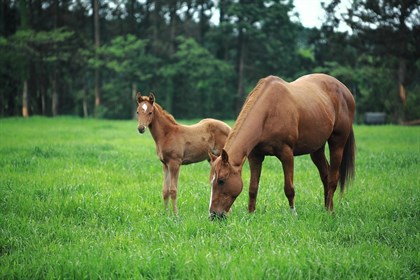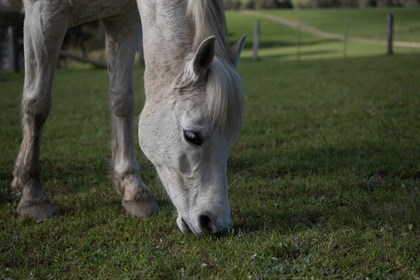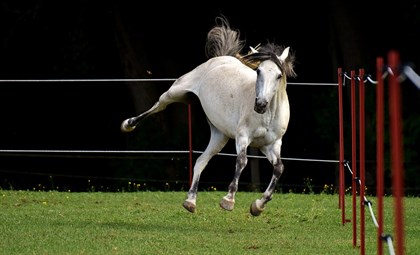
This article was first published in Issue 15 of Equestrian Life, to see what is in the current issue, please click here.
With the days becoming longer and warmer as spring sets in, the pasture is jumping up and the horses are shedding their coats. You're keen to throw off the winter blues and spend more time in the saddle, but make sure you help your horse acclimatise first.
By ANTOINETTE FOSTER, equine nutritional therapist and medical herbalist
IT IS IMPORTANT to monitor the condition of your horse at all times, of course, not just in spring. But many horses can lose weight over the winter months, while some actually put weight on and can become a little too fat. It is very important to look at the horse’s diet according to his genetic predisposition. This will include the breed, its weight, height, location, workload, type of pasture and a number of other factors that will affect a horse’s diet. It is also important to remember that during the spring months, pasture tends to be very nutritious so horses that do gain weight quickly will need to be monitored more closely.
Roughage is the most important part of your horse's feeding regimen. It is very common during the winter months to feed extra roughage in the form of hays to maintain body condition. However, when pastures improve in the spring it may be necessary to adjust the amount of roughage being fed.
Horses lose their coat going into spring due to the longer days and warmer weather, so it is important that you groom them to remove the shedding coat, which can also increase the process. Horses feel uncomfortable during this time and assisting in removing the coat is of great advantage to their health, ensuring a healthy coat comes through. Nutrition, as usual, plays a huge role in assisting this shedding process. If there is a short supply of specific nutrients such as protein and amino acids, this deficiency will have an effect on slowing the shedding of your horse's coat. It is well known and documented that oils such as omega three and omega six fatty acids can help improve our horse’s coat. My preference is always soy oil as it is very high in these essential fatty acids. A good supplement that provides your horse with sufficient amino acids, some essential fatty acids and vitamins will be of enormous benefit. There is no doubt that like human hair, a horse's coat is affected by nutrition in a big way.
It is very important to keep a watchful eye on the horse’s body condition to make sure that he is not consuming too much green grass. Early spring grass contains a higher level of sugars, starch and calories; this is why sometimes your horse may appear to be feeling well. Other problems that can occur with spring grass can be diarrhoea and other digestive upsets. Many horses will benefit from a pro-and pre-biotic. Older horses and horses prone to laminitis could be affected by these high levels of sugars and starch.
It will be necessary to adjust the amount of feed you are providing your horse at this time of the year. This is certainly not the case for all horses but most will always do far better on spring pasture than winter pasture. Make sure you adjust the amount according to the horse's work level. As the pasture improves it may be necessary to decrease the amount of hard feed being provided, but it is necessary to ensure that the horse is receiving sufficient carbohydrates in the diet to support the work required.
No matter what time of the year, your horse always requires fresh water. As the temperature increases and horses are working more frequently, they will tend to sweat more in the warmer months. So it is very important to ensure that the horse remains hydrated at all times. During the warmer months, horses also tend to lose electrolytes, which include potassium, sodium and chloride, and it may be necessary to supplement with a good natural electrolyte product.
Make sure that your horse does not have too much grass suddenly, due to the richness of the grass and the high nutritional level. It is recommended to graze horses prone to laminitis for short periods of time. Tips to maintain healthy pasture include avoiding allowing your horses out on pasture that has been quite wet until it dries out sufficiently. Drainage is of enormous benefit to managing properties as I have just recently found out. It makes a huge difference to be able to take the water away from your paddocks with good drainage. It is quite cost-effective to organise your paddocks in this way.
Make sure you rotate your paddocks and move your horses around as often as you can, as this will ensure healthy paddocks on a long-term basis. Keeping paddocks harrowed or picking up manure on a regular basis will also help. Spreading some grass seed, particularly native grass seed, which is hardier, will also ensure a good level of pasture growth when needed the most.
If you have small acreage there is still no reason why you cannot provide enough paddocks to ensure rotation. Your horses will graze more evenly throughout these paddocks. Even a small acreage such as two to five acres is quite sustainable in this manner.
In summary, always remember with performance horses that they require a good, balanced diet to ensure health and wellbeing on a long-term basis. This diet should always include a high level of roughage in the form of hays and/or grazing. Spring grass can create problems with horses due to its greater nutritional level. A feed ration containing some grains such as barley or oats, or using a compressed pellet that incorporates alfalfa, cereal hay and other types of hays, is good. Compressed pellets are also highly nutritious, healthy and dust free. Remember to supply sufficient fresh water and a good natural daily formula plus electrolytes if needed.
This article was first published in Issue 15 of Equestrian Life.
READ THE LATEST NEWS ARTICLES HERE
https://www.equestrianlife.com.au/articles/Spring-Feeding_



